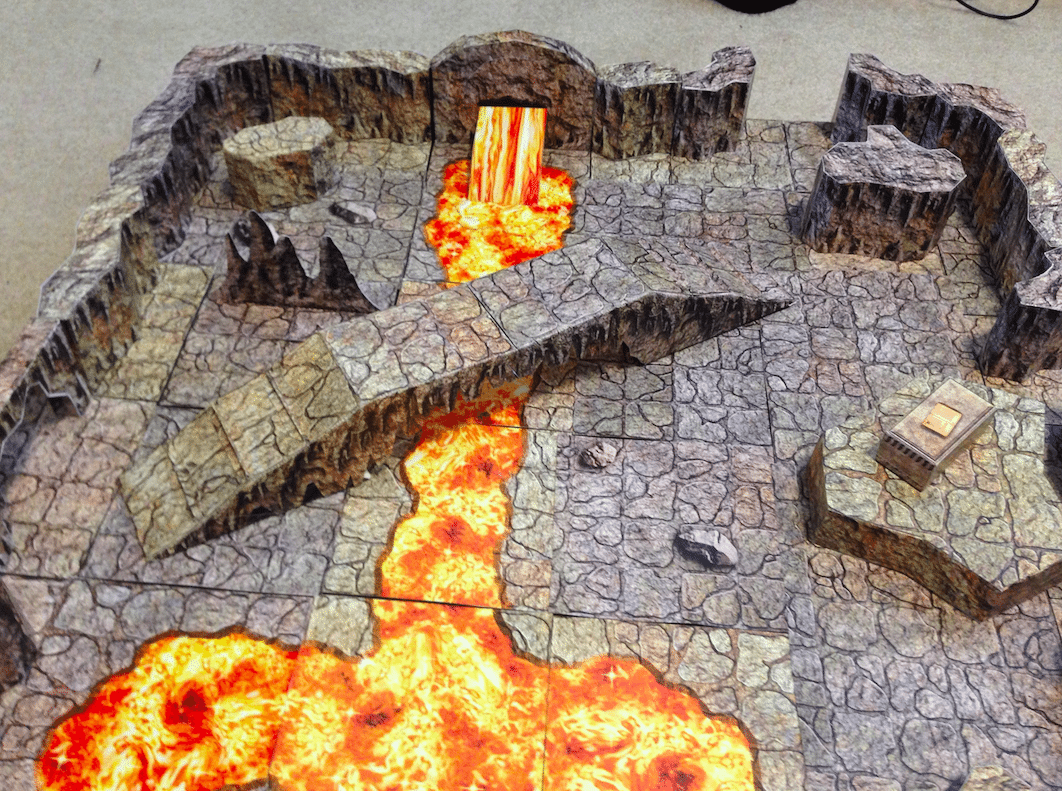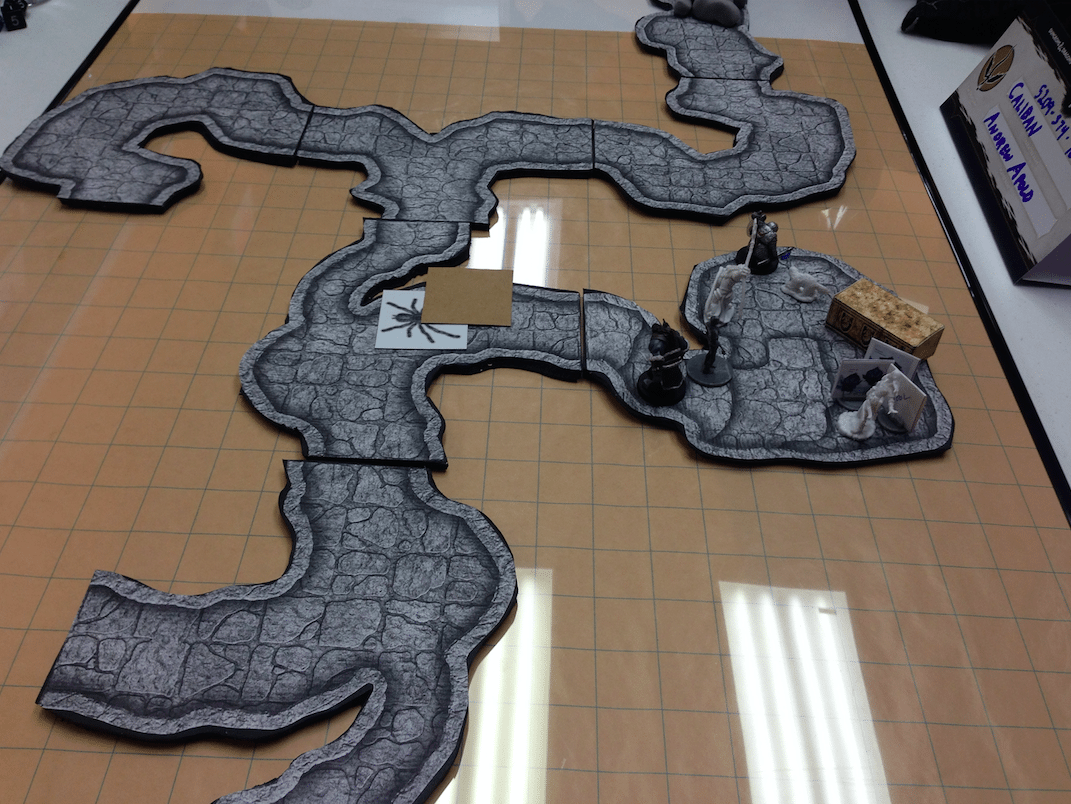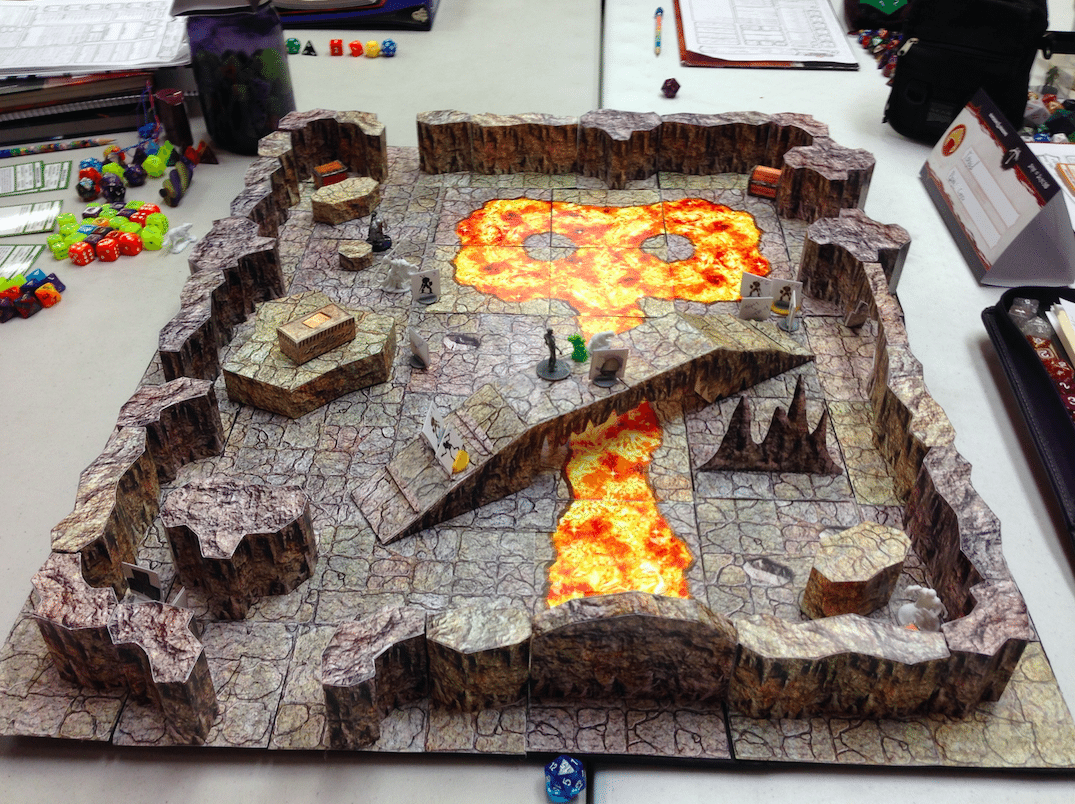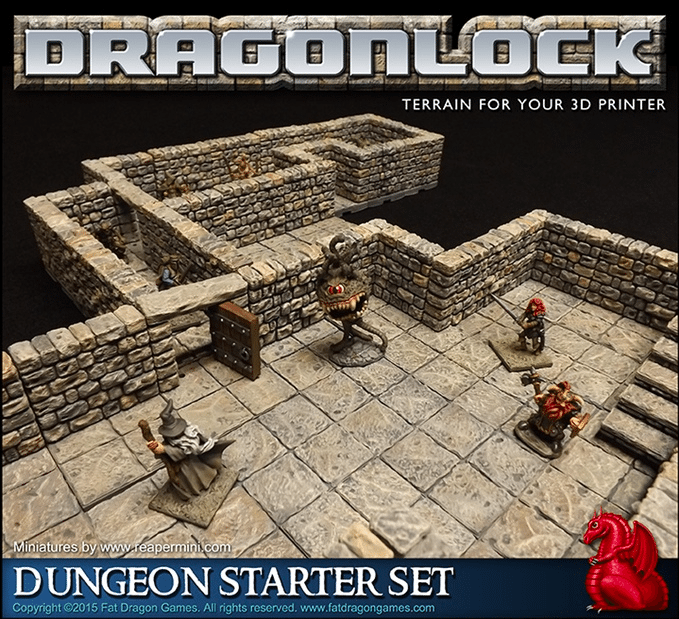I love being a DM. It scratches a creative itch for me. Creating an adventure, running it, improvising when necessary to counter whatever craziness the players throw my way–these are all aspects of the job that I absolutely enjoy. Toss in the smiles and laughs of my players at the end of a session as they recall one or two significant events from the night, and there are moments when I could be convinced to actually pay to sit in that chair.
For my weekly two-hour stint in the DM’s chair, I do try to occasionally shake things up a bit and bring something new or unusual to my table. My typical “special” usually involves some 3D aspect of a night’s adventure, and previous examples have included a six-level spiral tower found in the Elemental Evil adventure and a mashup of X-COM and D&D that had me creating a two-level UFO that the characters found in the middle of a dark wood. I’m a big fan of using my (limited quantity) Dwarven Forge terrain tiles whenever possible, too.
For this season’s Adventurers League sessions, I’m running my players through the new Out of the Abyss adventure. These sessions have found the players escaping from a drow compound in the Underdark and looking for a way back to the surface. Of course, this involves lots of caves and tunnels and such. My go-to solution is typically using large gridded sheets for special encounter rooms, caverns, and other areas where an accurate floor plan is helpful for both players and DMs. But what about the tunnels? I wanted to give players a sense of being lost, maybe even getting turned around and questioning where they were, so I started searching online and found an excellent resource at Fat Dragon Games. Taking a tour of their paper craft offerings, I stumbled upon the company’s Copper Dragon line of 2D terrain.
In terms of price, it’s hard to beat what Fat Dragon Games offers here–a PDF bundle of various bird’s-eye view terrain with plenty of variations. I purchased the Caverns 1 offering for $4.00 and, after discovering just how great this product is, I immediately purchased the Caverns 2 document as well. Between these two documents, I found enough variations of twisting, turning tunnels and dead-ends and forks to create something memorable. Even better, each PDF document has little thumbnails of the larger full-page shapes. There are about a dozen thumbnails per page, so I printed out about 2 of each page and then cut out these little thumbnails (in the image below) and used them like jigsaw puzzle pieces to assemble a decent maze.
After shaping the maze, I printed out the larger, full-size sheets (each 8.5×11 sheet contained one of the thumbnails you see above), cut them out, and used some spray adhesive to attach them to some foam core board. A box cutter helped me trim out just the shapes, and what was left over was placed, one tile at a time, for my players as they moved and explored. (I changed the maze a bit, adding a chasm from Caverns 2 and a few other elements not shown in the thumbnails image.)
These 2D tiles were a hit with my players, and I have no doubt I’ll be returning to purchase more of the 2D terrain tiles in the future. All of these tiles, however, were made a few weeks prior to actually using them, so after having completed the tiles and figuring out what would happen once they got out of the maze, I realized that I really wanted to do something fun and unique for my players as well as for myself. I’d seen some of the 3D terrain that Fat Dragon offered, so I returned again to their website and began hunting around. I found the Caverns of Chaos and knew immediately that I had to give it a try.
Consider yourself warned–the 3D terrain can be time-consuming to assemble as well as addictive once you get started making 3D walls and other obstacles. What caught my eye with this collection was the lava elements. Lava equals danger (and fun for a DM!) so I purchased the PDF ($13.00) and spent about $40 in color printing fees.
Note: I purchased a 250-page ream of card stock from my print shop to save some money–$0.04 cents per sheet versus having the print shop do it for me at $0.10 per sheet. I used the self-serve copier and my own paper at a cost of $0.64 per color page.
The PDF comes with some suggested patterns for creating large and small chambers using the walls and openings and other cave elements. I was going for something on the medium to large scale, so I knew I’d be looking at about 25-40 elements not counting the 2D flooring. I did a rough inventory and printed out a bunch of 2″ walls, 4″ walls, a bunch of corners, and half a dozen unusually shaped intersection-type pieces. Printing was the easy part.
Let me go ahead and tell you now… in terms of putting together a 3D papercraft terrain map, I rank the following tasks from most annoying to least annoying: gluing, folding, cutting.
Cutting isn’t too bad. I just took a few nights after the kids were in bed and started cutting. And continued cutting. And then I cut some more. Then, a few nights of folding. LOTS of folding. Lots of tabs to fold under (where glue will be applied) and the wall sides. Then the REAL pain kicked in. Gluing. Bleh. I think gluing has convinced me that 3D papercraft terrain will be a rare and random event for my players. It’s tedious, and I managed to get three or four elements glued up each night before I just couldn’t do anymore. But all that cutting and folding and gluing paid off when I brought in my little diorama and popped it down on the table after the players had managed to enter the room. Here it is, the Cave of Keys (explanation after the image):
Yeah, that’s a stone bridge over the lava flow. And there are stalagmites. A bunch of stone pedestals of various sizes, too. It’s fun to look at, and running it last night (for a 2 session adventure) made all that cutting and folding and gluing worth it. Sort of.
Again, this isn’t something I will be doing frequently. It’s very time-consuming (and although the price isn’t bad for printing, I couldn’t really afford to do one of these on a weekly or even bi-monthly basis) and often frustrating when it comes to the gluing. (You may LOVE the gluing part, so don’t take my experience as typical.) But it sure is impressive when you have it laid out in front of you. Combat becomes a bit more interesting with actual obstacles and interruptions in line-of-sight. My players stumbled upon a crazy half-elf warlock who had been using this little area as a testing ground for some upgrades to various creatures. Think Thunderdome, but with six players up against zombies, skeletons, and… other stuff I can’t yet mention. This is meant to be a 2-session adventure, so things will wrap up next week and I’ll take the terrain home and put it away, probably only to be used once or twice more for a game of Adventure Maximus for my son and his friends.
If you’re a DM, I highly encourage you to check out Fat Dragon Games and the various 2D and 3D products they offer. It’s much less expensive than the solid 3D elements offered by companies like Dwarven Forge, but admittedly not as fast or easy to assemble. As I said, I’ll definitely be returning to buy more of the 2D terrain elements, as they’re outstanding IMO.
But that’s not the end of the story when it comes to Fat Dragon Games. Just a few days ago, the company announced a new Kickstarter called DragonLock that I immediately backed. FDG is now going to be offering up digital files for use with 3D printers. These are similar to the Dwarven Forge tiles, but the cool part is that I can print as many as I need… the only limit is running out of plastic filament. I’m quite impressed with both the look and design of the basic Dungeon Starter Set. FDG has six pledge levels ranging from $10 to $60, with the $10 getting you the STL files for 7 unique pieces. More pieces are added as the backer level increases, all the way up to the $60 KING level that gives you 43 unique designs that are yours forever. The company has added Stretch Goals with 11 already unlocked and four more waiting. (And I believe they’ll be adding more if I understand some of the comments correctly.) Ultimately, what this means is a TON of digital files that I can print out and use however I like. I knew my 3D printer would come in handy one day!
I know a few DMs that prefer theater-of-the-mind style gaming, and there’s nothing wrong with it. In the right DM’s hands, imagination can work wonders. But that’s not my style. I want some visual elements to help me coordinate and manage exploration and combat, and between the 2D and 3D papercraft elements and now the 3D printed tiles, I think I’m going to be able to offer up my players (and my boys) some amazing sights in the coming years.
I love being a DM.
Note: I absolutely LOVE seeing photos of 2D and 3D adventure layouts, so please share if you’ve got them. And if you know of other good sources for 2D and 3D aids, please use the comments section and share those as well. Thanks! – JFK









What I wouldn’t give to have even a semi regular gaming schedule. Once my friends hit their mid to late twenties it was very hard to keep campaigns going. How do you stay so regular? From time to time we use roll 20, which is a nice browser based platform. I’m hoping one day someone makes use of augmented reality and tablets to make an interactive digital experience.
Hi, Joe.
I’m fortunate that I joined the Adventurers League at a local comic book shop, Titan Games & Comics. It’s not always 100% consistent with the same players at my table every week, but maybe 80%. The usual problem is either someone sick or having to work late (games run 6:30pm to 8:30-9ish). We have four tables, four DMs, and average 5-6 players per table. Players try to sit at the same table each week, but it’s not guaranteed. As a DM, I just roll with it…
Not sure where you live, but maybe check out the Adventurers League website and see if there’s something in your area? https://dnd.wizards.com/playevents/organized-play
I love the intersection of tabletop and crafts. From building awesome storage chests and components for board games, special props and terrain for RPGs, and my dreams of one day crafting the perfect table on which to place all of this stuff…
Just wish I had more time!
http://www.thedmg.info/
Oh, yeah… quite familiar with Dungeon Master G. He’s got some great tutorials on YouTube. Thanks, Mark, for sharing the link!
Check out Under the tavern! adventure.
Take a look at printablescenery.com and Google for “openforge thingiverse ” 🙂 I’m in for the fdg kickstarter, too. 🙂
Thanks, Andreas!
Great article. I’ve order a few sets and have been really pleased with them. I’ve not built much yet other than a few buildings. Very cool that on some they have included extra layers you can turn on and off to add things like doors, windows, cracks, vines, blood, etc to customize it to you adventure. Make sure to sign up for their newsletter. They have really good sales pretty often and every once in a while will send out a free PDF.